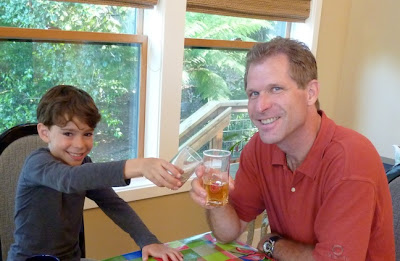 |
| Apple juice is high in sugar and should be saved for special occasions - like making toasts! Also water it down with bubbly or filtered water. Follow Foods For Long Life on FACEBOOK ! |
Latest Food Safety Issue
Consumer reports magazine tested 88 samples of apple and grape juice from grocery store shelves. Ten percent of them had arsenic levels that exceeded 10 parts per billion, the U.S. federal drinking water standards. Most of the arsenic was inorganic which is a known carcinogen that has been linked to bladder, lung and skin cancer. Twenty five percent of the juice samples also exceeded the 5 parts per billion level for lead.
Arsenic - Not the Real Issue
The associated press ran an article yesterday reminding us that it's not the arsenic in the apple and grape juice we should be worried about. I'm not saying that we shouldn't be concerned that the juice industry is supplying products with dangerous carcinogens. I am just agreeing with the main point of the article which is:
THE SUGAR IN THE JUICE IS THE REAL DANGER!
So instead of giving your children juice, give them a piece of fruit. Pop some apple or orange slices or grapes in their lunch sac instead of a juice box. Not only does the whole fruit provide fewer calories and grams of sugar, it also provides 3 to 6 times the fiber. The fiber in the fruit will stabilize their blood sugar instead of spiking it. If you're at home sipping wine with your spouse and the kids want a "special" drink too, give them bubbly water with just a splash of juice.
The Numbers
Since most of you will agree that sugar in excess quantities is bad for your kids, I need not dwell on that. I will, however, show you why fruit is so much better than its juice.
* 1 cup of apple slices has only 1/2 the calories, 5 times the fiber and less than 1/2 the sugar as 1 cup of unsweetened apple juice!
 |
| 1 cup of unsweetened apple juice has: 114 calories, 1/2 g fiber and 24 g sugar. 1 cup apple slices has: 57 calories, 2.6 g fiber and 11 g sugar. |
* 1 Navel orange has only 62% of the calories, 6 times the fiber and 57% of the sugar as 1 cup of unsweetened orange juice!
 |
| 1 cup of unsweetened orange juice has: 112 calories, 1/2 g fiber and 21 g sugar. 1 navel orange has: 69 calories, 3.1 g fiber and 12 g sugar. |
* 1 cup of grapes has 1/3 fewer calories, 3 times the fiber and 1/3 less sugar as 1 cup of unsweetened grape juice! Frozen grapes can be a real treat and a great low calorie dessert but be aware that for young children, these could be a choking hazard.
 |
| 1 cup of grape juice has: 152 calories, 1/2 g fiber and 36 g sugar. 1 cup grapes has: 104 calories, 1.4 g fiber and 23 g sugar. |
Another Advantage of Eating the Whole Fruit
Besides having more nutritional value and less sugar, eating the whole fruit should make you feel safer. Safer because you can see what you are eating! You can tell the fruit is fresh and clean. We don't know the condition of the fruit that goes into making juice. Of course, we can assume the best apples and other fruits are sold as fresh produce. The ones that fall off the trees and have dents and worms (what a disgusting thought) are probably the ones that end up in the juice! Add to that the fact that 83% of the apple juice sold in the U.S. is produced in other countries, (60% of which is from China), where we have little control of their food safety practices. I think I'll stick to eating nice local apples.
How to Get Kids to Eat Fruit
Eating fruit is all about convenience. I would never think of biting into an apple when I was at work. But every morning my husband put a little bag of sliced apples in my Hello Kitty power lunch box and I munched on them all morning. I would bet that your kids are the same way. If you stick an apple or an orange in their lunch box, there's a good chance that it will still be there when they get home. But apple slices, peeled orange slices and grapes plucked and ready to eat might get more attention!
So you and your children should enjoy juice as an occasional treat, not a daily beverage. Dilute it with filtered or bubbly water and use it more as a flavoring. Skip the juice boxes in the lunch sac and put in sliced, peeled or plucked fruit for your child to conveniently enjoy!
No comments:
Post a Comment